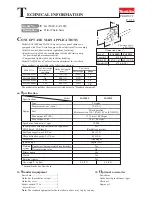
21
GB
12. Cleaning, maintenance, and
storage
m
Important!
Prior to any adjustment, maintenance or service work discon-
nect the mains power plug!
Cleaning
Keep all safety devices, air vents and the motor housing free
of dirt and dust as far as possible. Wipe the equipment with
a clean cloth or blow it with compressed air at low pressure.
We recommend that you clean the device immediately each
time you have finished using it.
Maintenance
There are no parts inside the equipment which require ad-
ditional maintenance.
Storage
Store the device and its accessories in a dark, dry and frost-
proof place that is inaccessible to children. The optimum stor-
age temperature is between 5 and 30˚C.
Store the power tool in original packaging.
Cover the electrical tool in order to protect it from dust and
moisture.
Store the operating manual with the electrical tool.
13. Disposal and recycling
The equipment is supplied in packaging to prevent it from be-
ing damaged in transit. The raw materials in this packaging
can be reused or recycled. The equipment and its accesso-
ries are made of various types of material, such as metal and
plastic. Defective components must be disposed of as special
waste. Ask your dealer or your local council.
The packaging is wholly composed of environment ally-
friendly materials that can be disposed of at a local recy-
cling centre.
Contact your local refuse disposal authority for more details
of how to dispose of your worn out electrical devices.
Old devices must not be disposed of with household waste!
This symbol indicates that this product must not be
disposed of together with domestic waste in compli-
ance with the Directive (2012/19/EU) pertaining to
waste electrical and electronic equipment (WEEE). This
product must be disposed of at a designated collection point.
This can occur, for example, by handing it in at an authorised
collecting point for the recycling of waste electrical and elec-
tronic equipment. Improper handling of waste equipment
may have negative consequences for the environment and
human health due to potentially hazardous substances that
are often contained in electrical and electronic equipment.
• Press the workpiece firmly onto the saw bench (7) and
slowly slide into the Bandsaw blade (21).
• In many cases it is helpful to roughly saw curves and cor-
ners approximately 6 mm from the line.
• If it is necessary to saw curves that are too tight for the saw
band used, auxiliary cuts must be sawn up to the front face
of the curve, so that these fall off as wood waste when the
final radius is sawn.
11. Electrical connection
The electrical motor installed is connected and ready for op-
eration. The connection complies with the applicable VDE
and DIN provisions.
The customer‘s mains connection as well as the extension ca-
ble used must also comply with these regulations.
Important information
In the event of an overloading the motor will switch itself off.
After a cool-down period (time varies) the motor can be
switched back on again.
Damaged electrical connection cable
The insulation on electrical connection cables is often dam-
aged.
This may have the following causes:
• Passage points, where connection cables are passed
through windows or doors.
• Kinks where the connection cable has been improperly
fastened or routed.
• Places where the connection cables have been cut due to
being driven over.
• Insulation damage due to being ripped out of the wall
outlet.
• Cracks due to the insulation ageing.
Such damaged electrical connection cables must not be
used and are life-threatening due to the insulation damage.
Check the electrical connection cables for damage regu-
larly. Make sure that the connection cable does not hang on
the power network during the inspection.
Electrical connection cables must comply with the applicable
VDE and DIN provisions. Only use connection cables with
the marking „H05VV-F“.
The printing of the type designation on the connection cable
is mandatory.
AC motor
• The mains voltage must be 220 - 240 V
~
50 Hz.
• Extension cables up to 25 m long must have a cross-sec-
tion of 1.5 mm
2
.
Connections and repairs of electrical equipment may only
be carried out by an electrician.
Please provide the following information in the event of any
enquiries:
• Type of current for the motor
• Machine data - type plate
• Machine data - type plate
Summary of Contents for PBS 350 A1
Page 6: ...15 16 14 12 48 26 13 6 24 21 25 10 5 21 11 49 50 12 7 7 7...
Page 7: ...19 17 18...
Page 31: ...24...
Page 33: ......
Page 35: ......









































